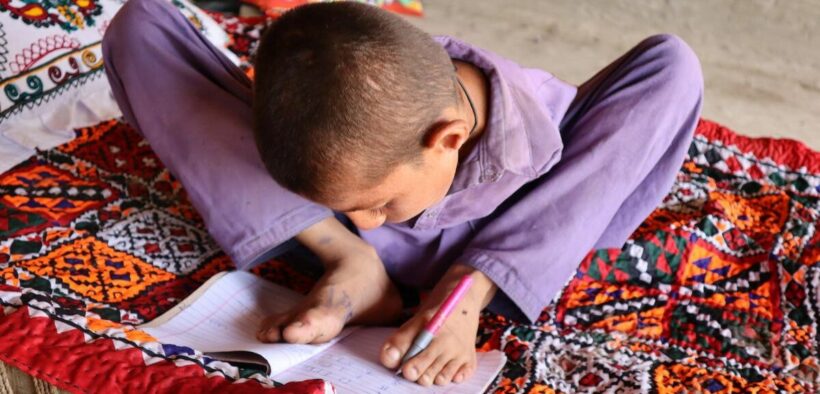One year after Pakistan’s worst floods on record, children are terrified of a repeat of the disaster that submerged a third of the country and claimed more than 1,700 lives, Save the Children said.
Children have told the child rights organisation that the death, destruction and displacement they lived through last year was still deeply affecting their lives and the past few months of monsoon rains and flooding in some of the same areas that were inundated last year have made them scared that it could happen again.
“These floods have devastated children’s homes, schools, physical and mental health – their entire lives. And yet many children are still without homes, 30,000 schools are still in need of urgent repair – and children are telling us they are terrified. I’ve heard their concerns and now we need to take action,” said Save the Children’s CEO, Inger Ashing.
About 8 million people were displaced at the height of the crisis although many people have now returned to their homes. There is no current data on how many people remain homeless or living in temporary shelters. Some schools damaged in the floods are yet to reopen and food prices have surged in recent months, raising concerns about child malnutrition in flood-affected areas.
Save the Children is calling on the world to stop looking away, and to pledge urgent financial support to fully fund a recovery that meets the needs of children. International donors also need to provide support that acknowledges the losses and damages that Pakistan has suffered as a result of the climate crisis – to which children and communities in the country have done little to contribute.
Ahmed Khan, 8, from Khairpur in Sindh province in south-central Pakistan, was nearly killed when the floods swept through his home. He said:
“Everything was flooded. My parents and uncle saved my life after a wall fell directly on me. I thought I would die. It took two months of medical care before I started feeling better, but I still get headaches now and then.
“I’m scared of going near buildings that might collapse. I’m terrified that something similar may happen again.
“My favourite food is chicken and roti (bread) but during the floods, we had to go to bed hungry as there was no food available. For three months, we had to survive on just rice.”
Safeer, 12, is also from Khairpur and was born with a disability that means he does not have any arms. He recalled the terror he felt as the waters approached his home:
“We suddenly heard people shouting and screaming loudly, followed by the flood. As the floodwater filled our entire house, we were in grave danger of drowning.
“We were drowning in water because our land was at a lower level than the surrounding area, which caused the water to flow to our land.
“In order to protect ourselves from flooding in the future, we are asking for homes in a safer location”.
Safeer had to flee his home but has luckily been able to return.
The impact of the climate crisis on the world’s most marginalised children is impossible to ignore in Pakistan, Save the Children said. Even before last year’s devastating floods, the country was ranked by the Global Climate Risk Index as the world’s eighth most vulnerable to climate change – while contributing less than 1% of the world’s total global carbon emissions.
In addition to the floods, parts of Pakistan are experiencing intensifying heatwaves and droughts, with temperatures reaching 50°C last spring. A long drought before last year’s heavy rainfall made the flooding more likely as the parched land could not quickly absorb the heavy rains.
Khairpur, which was at the epicentre of last year’s floods, is also one of the hottest places in Pakistan. Temperatures here regularly exceed 40°C, jeopardising children’s health and wellbeing. More than 800,000 children in Sindh were at risk of severe heat stress in June 2023.
For Safeer, these heatwaves are also jeopardising his right to play as he is forced to stay inside to shelter from the scorching sun. He said:
“I have noticed temperatures rising and stronger sunshine. We avoid going outside due to the heat because the sun’s beams are so intense.”
Soaring food prices have further exacerbated food shortages for families. In July, the cost of food increased by 40% compared with the same month in 2022. Food shortages are estimated to impact even more people towards the end of 2023, potentially pushing more and more children into hunger and malnutrition. In the flood-affected areas, an estimated 3.5 million children are severely malnourished.
Save the Children also raised the alarm about extreme weather events projected as a result of climate change and further compounded by the naturally occurring El Nino phenomenon which is likely to increase global temperatures even further. Pakistan could see reduced rainfall that may lead to drought, with the impact on crops, livestock and food production peaking next year.
The effects that the flooding has had on children in Pakistan show how vulnerable they are to the impacts of the climate crisis.
“Only through bold measures can the lives, hopes and futures of millions of children in Pakistan recover and be protected from future disastrous impacts of the climate crisis,” added Ashing.
“The international community must take a three-pronged approach – it must fully fund the ongoing humanitarian response; it must fully fund Pakistan’s ambitious recovery and climate resilience plan; and it must make bold commitments at COP28 to support countries, like Pakistan, for the climate related loss and damages they have incurred and will continue to endure. Ensuring that children’s rights, voices, and unique experiences are at the heart of this approach must be a priority.”
12-year-old Safeer, who has a disability, writing with his feet. Safeer’s home is low down and was badly affected by flooding. Photo by Save the Children.
Menchie Khairuddin is a writer Deputy Content Manager at Akolade and content producer for Third Sector News. She is passionate about social affairs specifically in mixed, multicultural heritage and not-for-profit organisations.


































































































































































